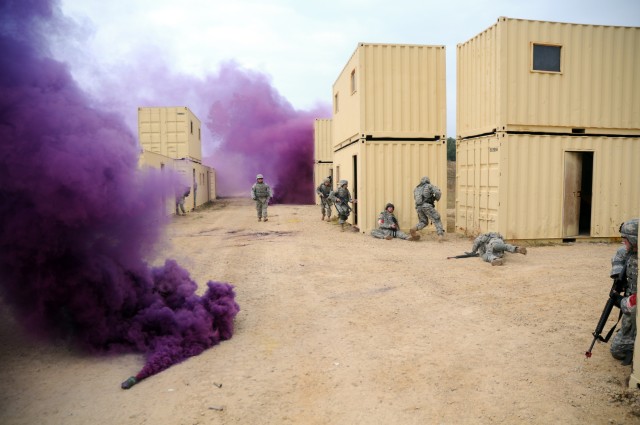FORT McCOY, Wis. -- Home Station Training Lanes (HSTL), an updated version of improvised explosive device (IED)-defeat lanes, now are part of the training available on Fort McCoy's South Post.
Steve Shanks, chief, Training Division, Directorate of Plans, Training, Mobilization and Security (DPTMS), said the HSTL plan is an initiative of the Army's Joint IED-Defeat Organization (JIEDDO). JIEDDO became operational in 2006 with a mission to provide deploying units with training on rapidly fielded counter-IED (C-IED) equipment and capabilities.
The HSTLs provide a demanding individual and collective training setting on IED-defeat operations, Shanks said. The facilities are used to prepare mobilizing and combat-support training exercise units with an "in-theater-like training environment prior to deployment into a combat theater of operations. It offers training units the ability to become proficient in C-IED tactics, techniques and procedures."
Shanks said the HSTL facilities include mock villages, barriers and guard rails, traffic circles (round-abouts), highways with multiple lanes, highway overpasses and paved and unpaved roads.
"Fort McCoy has two completed HSTLs, while most military training installations only have one," Shanks said. "Construction on the first began using the Engineer Troop Projects program and was funded by DPTMS. Then $1.4 million in funding was provided by JIEDDO for the second HSTL."
"In addition to construction costs, the HSTL initiative included vehicle-mounted IED-Defeat equipment," he said. "JIEDDO also provides two contract personnel under an Installation Management Command contract to maintain IED-defeat equipment and assist unit trainers utilizing the HSTLs."
"The DPTMS Range Branch continues to make improvements to the HSTLs," Shanks said. "These improvements were made with more than $2 million in installation funding in 2009 to provide a more-realistic and effective training environment for our training customers."
Improvements to mock villages alongside the Fort McCoy training roads have become more noticeable in the last three years, growing slowly, but steadily.
The village at Mobile Urban Training Site (MUTS)-South, is a collection of about 40 sea-land shipping containers, conex-like boxes, with door and window cutouts, arranged like village houses and businesses.
In recent months "military wraps," with photo-like images of buildings in Afghanistan and Iraq, have been applied to the HSTL building exteriors at Fort McCoy.
A pedestrian walkway overpass was constructed recently at MUTS-South, which is on HSTL 2, replicating what is common in south-central Asian communities.
Three 40-foot high, pre-cast concrete minarets have been constructed, one each at MUTS-South, MUTS-North and at a major road intersection which is the start of HSTL 1 on South Post.
A new Afghan-style farm village has been constructed on HSTL 2 between MUTS-South and Scotts Junction. The village is made of 30 pre-cast concrete "cubes" packed together with doors and windows facing only in toward a courtyard-like center.
A similar village is planned for construction on HSTL 1.
Shanks noted that the JIEDDO program is in place at about 60 installations in the U.S., Korea and Europe.
It supports Army, Navy, Air Force and Marine Corps training programs.


Social Sharing